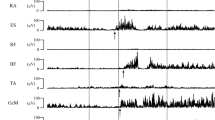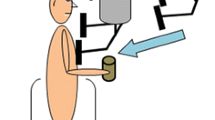Abstract
We evaluated the development of postural adjustments accompanying reaching movements in sitting children. Twenty-nine typically developing children aged, 2–11 years, and ten adults were studied with multiple surface electromyograms (EMGs) and kinematics during reaching in four conditions: sitting with the seat-surface oriented horizontally with and without an additional task load, and sitting with the seat-surface tilted 15° forward and 15° backward. The development of postural adjustments during reaching in a sitting position turned out to have a non-linear and protracted course, which is not finished by the age of 11 years. The development of these adjustments is characterised by variation, yet specific developmental sequences could be distinguished. Firstly, the development of postural adjustments during reaching from the age of 2 years onwards lacked a preference for an en bloc strategy, which consists of an in concert activation of the direction-specific neck and trunk muscles. Secondly, anticipatory postural muscle activity, which was consistently present in adults, was virtually absent between 2 and 11 years of age. Thirdly, the data demonstrated that with increasing age the head gradually becomes the dominant frame of reference. In addition, the study suggested that, in terms of postural control, the forward-tilted position is the most efficient one.










Similar content being viewed by others
References
Aruin AS, Forrest WR, Latash ML (1998) Anticipatory postural adjustments in conditions of postural instability. Electroencephalogr Clin Neurophysiol 109:350–359
Assaiante C (1998) Development of locomotor balance control in healthy children. Neurosci Biobehav Rev 22:527–532
Assaiante C, Amblard B (1993) Ontogenesis of head stabilisation in space during locomotion in children: influence of visual cues. Exp Brain Res 93:499–515
Assaiante C, Woollacott M, Amblard B (2000) Development of postural adjustment during gait initiation: kinematic and EMG analysis. J Mot Behav 32:211–226
Berger W, Trippel M, Assaiante C, Zijlstra W, Dietz V (1995) Developmental aspects of equilibrium control during stance: a kinematic and EMG study. Gait Posture 3:149–155
De Wolf S, Slijper H, Latash ML (1998). Anticipatory postural adjustments during self-paced and reaction-time movements. Exp Brain Res 121:7–19
Forssberg H, Hirschfeld H (1994) Postural adjustments in sitting humans following external perturbations: muscle activity and kinematics. Exp Brain Res 97:515–527
Forssberg H, Nashner LM (1982) Ontogenetic development of postural control in man: adaptation to altered support and visual conditions during stance. J Neurosci 2:545–552
Gerver WJM (1988) Measurements of the body proportions in children. The Oosterwolde study. PhD Thesis, University of Groningen
Haas G, Diener HC, Rapp H, Dichgans J (1989) Development of feedback and feedforward control of upright stance. Dev Med Child Neurol 31:481–488
Hadders-Algra M, Brogren E, Forssberg H (1996) Ontogeny of postural adjustments during sitting in infancy: variation, selection and modulation. J Physiol 493:273–288
Hadders-Algra M, Brogren E, Forssberg H (1998) Postural adjustments during sitting at pre-school age: presence of a transient toddling phase. Dev Med Child Neurol 40:436–447
Hay L, Redon C (1999) Feedforward versus feedback control in children and adults subjected to a postural disturbance. Exp Brain Res 125:153–162
Henderson SE, Sugden DA (1992) The movement assessment battery of children (MABC). Psychological Corporation, Kent UK
Horak FB, Esselman P, Anderson ME, Lynch MK (1984) The effects of movement velocity, mass displaced, and task certainty on associated postural adjustments made by normal and hemiplegic individuals. J Neurol Neurosurg Psychiatry 47:1020–1028
Kirshenbaum N, Riach CL, Starkes JL (2001) Non-linear development of postural control. Exp Brain Res 140:420–431. DOI 10.1007/s002210100835
Massion J, Ioffe M, Schmitz C, Viallet F, Gantcheva R (1999) Acquisition of anticipatory postural adjustments in a bimanual load-lifting task: normal and pathological aspects. Exp Brain Res 128:229–235
McClenaghan BA, Thombs L, Milner M (1992) Effects of seat-surface inclination on postural stability and function of the upper extremities of children with cerebral palsy. Dev Med Child Neurol 34:40–48
Moore S, Brunt D, Nesbitt ML, Juarez T (1992) Investigation of evidence for anticipatory postural adjustments in seated subjects who performed a reaching task. Phys Ther 72:335–343
Myhr U, Von Wendt L (1991) Improvement of functional sitting position for children with cerebral palsy. Dev Med Child Neurol 33:246–256
Pozzo T, Berthoz A, Lefort L (1990) Head stabilisation during various locomotor tasks in humans. I. Normal subjects. Exp Brain Res 82:97–106
Pozzo T, Levik Y, Berthoz A (1995) Head and trunk movements in the frontal plane during complex dynamic equilibrium tasks in humans. Exp Brain Res 106:327–338
Riach CL, Hayes KC (1990) Anticipatory postural control in children. J Mot Behav 22:250–256
Riach CJ, Starkes JL (1994) Velocity of centre of pressure excursion as an indicator of postural control systems in children. Gait Posture 2:167–172
Schmitz C, Martin N, Assaiante C (2002) Building anticipatory adjustment during childhood: a kinematic and electromyographic analysis of unloading in children from 4 to 8 years of age. Exp Brain Res 142:354–64 DOI 10.1007/s00221–001–0910-y
Shumway-Cook A, Woollacott MH (1985) The growth of stability: postural control from a developmental perspective. J Mot Behav 17:131–147
Van der Fits IBM, Klip AWJ, Van Eykern LA, Hadders-Algra M (1998) Postural adjustments accompanying fast pointing movements in standing, sitting and lying adults. Exp Brain Res 120:202–216
Van der Fits IBM, Klip AWJ, Van Eykern LA, Hadders-Algra M (1999a) Postural adjustments during spontaneous and goal-directed arm movements in the first half year of life. Behav Brain Res 106:75–90
Van der Fits IBM, Otten E, Klip AWJ, Van Eykern LA, Hadders-Algra M (1999b) The development of postural adjustments during reaching in 6- to 18-month-old infants: evidence for two transitions. Exp Brain Res 126:517–528
Woollacott M, Debû B, Mowatt M (1987) Neuromuscular control of posture in the infant and child: is vision dominant? J Mot Behav 19:167–186
Acknowledgements
We thank Prof. Dr. O. F. Brouwer for his critical and valuable remarks on a previous draft of this manuscript. Ms. A.A. Kingma-Balkema and Drs. J.J.A.M. Schaap are kindly acknowledged for the skilful technical assistance. The study was supported by the Johanna KinderFonds (Grant number 19990021), the Dr. W.M. Phelps-Stiching voor Spastici (Grant number 99.058) and the Gratama Stichting/Groninger Universiteits Fonds.
Author information
Authors and Affiliations
Corresponding author
Rights and permissions
About this article
Cite this article
van der Heide, J.C., Otten, B., van Eykern, L.A. et al. Development of postural adjustments during reaching in sitting children. Exp Brain Res 151, 32–45 (2003). https://doi.org/10.1007/s00221-003-1451-3
Received:
Accepted:
Published:
Issue Date:
DOI: https://doi.org/10.1007/s00221-003-1451-3




